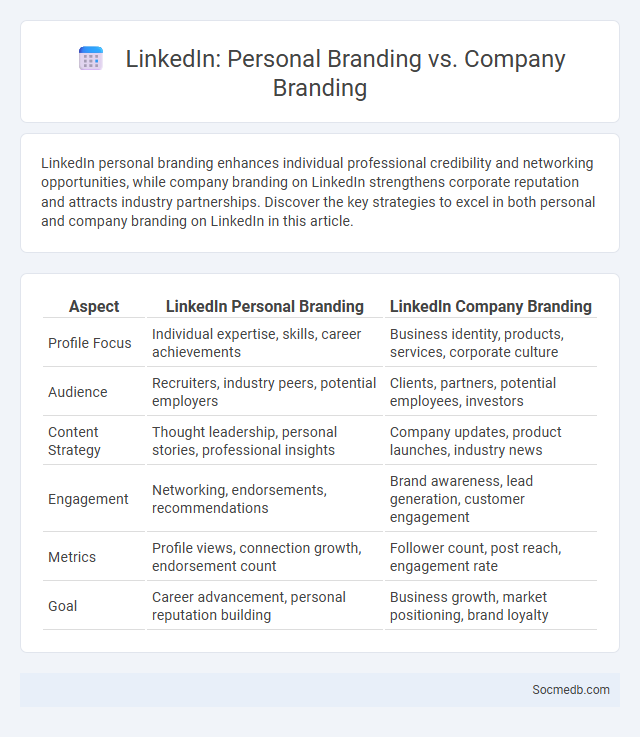
Photo illustration: LinkedIn personal branding vs company branding
LinkedIn personal branding enhances individual professional credibility and networking opportunities, while company branding on LinkedIn strengthens corporate reputation and attracts industry partnerships. Discover the key strategies to excel in both personal and company branding on LinkedIn in this article.
Table of Comparison
| Aspect | LinkedIn Personal Branding | LinkedIn Company Branding |
|---|---|---|
| Profile Focus | Individual expertise, skills, career achievements | Business identity, products, services, corporate culture |
| Audience | Recruiters, industry peers, potential employers | Clients, partners, potential employees, investors |
| Content Strategy | Thought leadership, personal stories, professional insights | Company updates, product launches, industry news |
| Engagement | Networking, endorsements, recommendations | Brand awareness, lead generation, customer engagement |
| Metrics | Profile views, connection growth, endorsement count | Follower count, post reach, engagement rate |
| Goal | Career advancement, personal reputation building | Business growth, market positioning, brand loyalty |
Understanding LinkedIn Personal Branding
Mastering LinkedIn personal branding involves crafting a consistent professional image through a well-optimized profile featuring a high-quality photo, compelling headline, and detailed experience. Engaging with industry-relevant content and expanding your network strategically enhances visibility and credibility among peers and potential employers. Leveraging LinkedIn's publishing tools and endorsements further solidifies your authority in your professional niche.
Key Elements of Company Branding on LinkedIn
Company branding on LinkedIn hinges on a cohesive visual identity, including a professional logo, banner image, and consistent color palette that aligns with the overall brand guidelines. Crafting a compelling company description enriched with industry-specific keywords enhances searchability and communicates core values, mission, and services effectively. Leveraging employee advocacy, regularly publishing thought leadership content, and engaging with followers through comments and messages strengthen brand credibility and foster community growth.
Defining Content Strategy for LinkedIn Success
Defining a content strategy for LinkedIn success involves identifying your target audience and tailoring posts to their professional interests and pain points. You should prioritize sharing insightful articles, industry updates, and engaging videos to boost visibility and establish authority in your niche. Consistent posting combined with strategic use of hashtags and LinkedIn analytics will help refine Your approach and maximize engagement.
Personal Branding vs. Company Branding: Core Differences
Personal branding on social media emphasizes your unique identity, values, and expertise to build trust and a loyal following, whereas company branding focuses on promoting the organization's mission, products, and culture to attract customers and stakeholders. Your personal brand requires authenticity and consistent engagement to establish credibility, while company branding demands strategic messaging and cohesive visual elements to strengthen market presence. Understanding these core differences helps tailor content that resonates effectively with individual or corporate audiences.
How Content Strategy Integrates with Branding
Your content strategy on social media directly influences your brand identity by consistently delivering messages that reflect your core values and voice. Integrating visual elements, tone, and storytelling in alignment with your branding ensures increased recognition and customer loyalty. Strategic content planning enhances engagement metrics, driving brand awareness and reinforcing your market positioning.
Benefits of Strong Personal Branding on LinkedIn
Strong personal branding on LinkedIn amplifies your professional visibility and attracts potential employers, clients, and collaborators by showcasing your expertise and achievements. Consistent, well-crafted content enhances your credibility and positions you as an industry thought leader, increasing opportunities for career growth. By optimizing your profile and engaging with relevant networks, you maximize the impact of your personal brand, making your professional presence more influential and valuable.
Advantages of Robust Company Branding on LinkedIn
Robust company branding on LinkedIn enhances professional credibility by showcasing company values, culture, and industry expertise to a targeted audience of decision-makers and potential clients. It increases visibility through tailored content and strategic networking, fostering trust and engagement that lead to higher quality lead generation and recruitment opportunities. Consistent branding also strengthens competitive advantage by establishing a memorable presence and positioning the company as a leader in its sector.
Aligning Personal and Company Brands with Content Strategy
Aligning your personal and company brands with a cohesive content strategy strengthens brand identity and builds trust across social media platforms. Consistent messaging and visuals tailored to your target audience enhance engagement and reinforce core values. Prioritizing authenticity and relevancy in your content creates meaningful connections that drive brand loyalty and business growth.
Common Mistakes in LinkedIn Branding and Content
Many professionals overlook the importance of consistent branding across their LinkedIn profile, leading to mixed messages that confuse your audience. Neglecting to tailor content to your target industry reduces engagement and misses opportunities to showcase your expertise effectively. Failing to engage with connections through thoughtful comments and shares diminishes your visibility and weakens your professional network growth.
Best Practices for Balancing Branding and Content Strategy
Effective social media management requires balancing branding consistency with diverse content strategies to engage target audiences. Prioritizing a cohesive brand voice while incorporating varied content types such as videos, stories, and user-generated content enhances audience interaction and retention. Leveraging analytics tools to monitor engagement metrics ensures the content strategy adapts to audience preferences without diluting brand identity.
 socmedb.com
socmedb.com